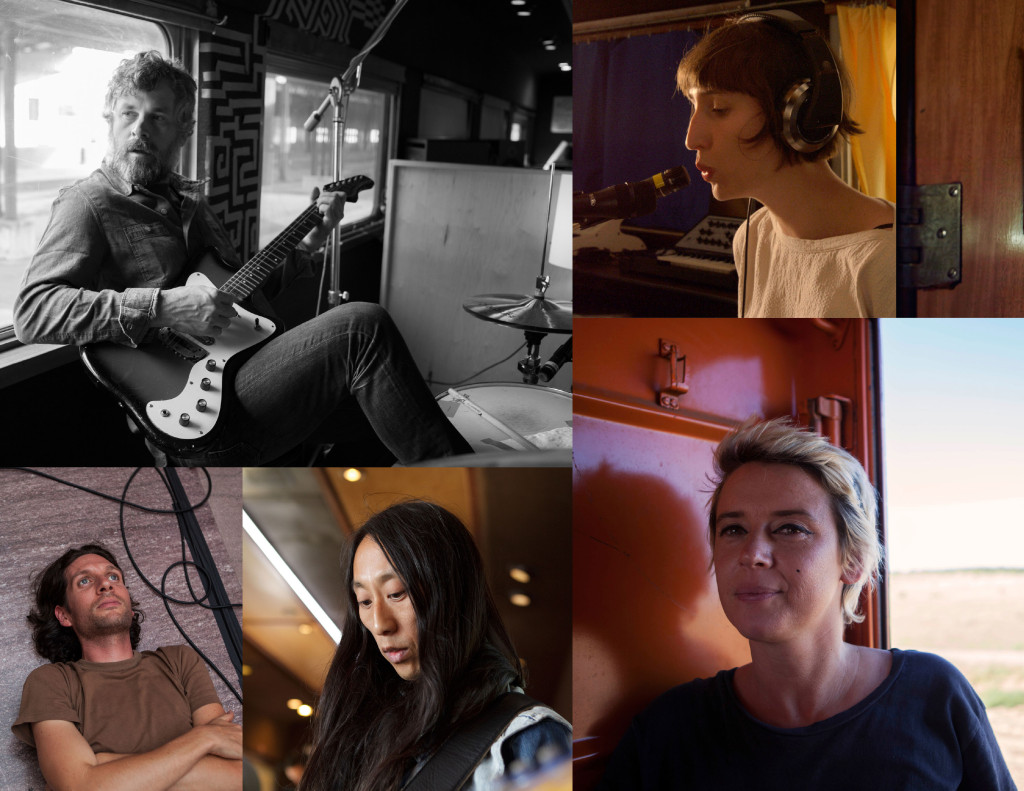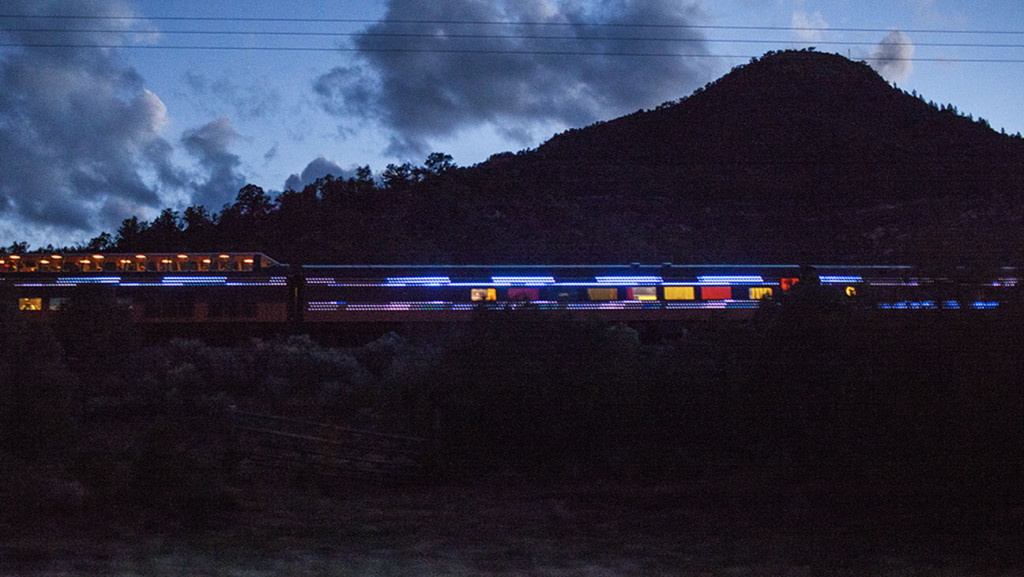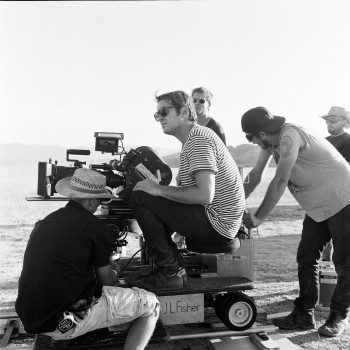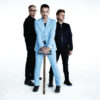Rico Gagliano: Our guest Doug Aitken is a major star of the contemporary art scene. His multimedia pieces have been shown around the world at the Whitney Biennial, MoMA, and more.
But his latest work is a movie, “Station to Station.” It documents his project of the same name, wherein he commandeered an intercontinental train and traveled on it across America, inviting dozens of artists aboard to make art and stage 10 “happenings” for audiences along the way. We’re talking everyone from little-known indie bands, to stars like Patty Smith, Thurston Moore, Jackson Browne, and Mavis Staples. Plus artists like William Eggleston, and Ed Ruscha.
The film rolls into theaters over the next few weeks, and Doug it’s a pleasure to have you.
Doug Aitken: Oh, thank you very much.
Rico Gagliano: What was the germ of this project? What’s the trigger for, “Oh yeah! An art train.”
Doug Aitken: Well, I was really attracted to the idea of displacement — making things outside of your safety zone, or outside of the neighborhood or city that you live in. And as I researched it more, I kind of looked at train system in North America, and I realized there’s these kind of arteries that just run through the landscape. And so much of it is largely unused. These stations are… you know they’re often WPA-era, old marble halls, or spaces in disuse. And, you know, could you activate those almost like one-night museums and create some kind of happenings with them?
Rico Gagliano: You use the term “happenings,” which is a word that connotes kinda ’60s Warhol, or hippie drug freakouts of the ’60s. Why use that word? Do you feel a connection, maybe, to road experiments of that era, like Ken Kesey’s Merry Pranksters?
Doug Aitken: Well I’ve always seen the term “happening” as just meaning something which is time based and volatile, and often a convergence of different mediums.
Rico Gagliano: So there is no ’60s connotation in that word to you at all?
Doug Aitken: Uh [laughs], you can do whatever you want there, but-
Rico Gagliano: It’s up to me?
Doug Aitken: It’s up to you.
Rico Gagliano: I will say that it actually reminded me of this movie “Festival Express,” which is about the Grateful Dead taking a tour of Canada by train in the 1970s.
Doug Aitken: I have seen it a while ago, yeah.
Rico Gagliano: Yeah, just getting a bunch of freaks on a moving conveyance and seeing what happens.
Doug Aitken: Yeah, and I think one of the things that’s very different about this project was, it’s not a tour. We didn’t have a group of people that toured across the country. The train was actually made for production. There is a recording studio on it, a film studio, editing.

Someone might use the train from point A to point B, like Giorgio Moroder, to record sounds that he’d then mix into a soundscape. Or someone else, like Patty Smith, says, “I’ve written this one song, and I will not play it in New York or Los Angeles. I will only play it in St. Paul.” So [laughs]…
Rico Gagliano: “I need a train for that.”
Doug Aitken: I guess so.
Rico Gagliano: Did you find something unifying in the work that was ultimately done? Like could you see the affect of motion on all of it?
Doug Aitken: Yeah, I think that sense of change, and coming in to a space which is completely unfamiliar, is liberating in a lot of ways. And it also is destabilizing, so it kind of makes one think, you know, “I don’t have the tools I’m used to” and, “Can I create with what’s around me?”
Rico Gagliano: I noticed a lot of the music actually did seem to have this kind of relentless chugging feeling. At one point you even overlap Thurston Moore’s music with the chugging of the train, in the film.
Doug Aitken: Thurston’s actually a very interesting example. There was a stretch from New York to Pittsburgh, where Thurston was on the train with some other musicians — members of the Boredoms, and Ariel Pink, and-
Rico Gagliano: Oh my God, that sounds insane [laughs]. For those that don’t know, the Boredoms are one of the most off the hook Japanese punk noise bands that’s ever existed, and I can’t imagine being trapped with them on a train. It must have been crazy.
Doug Aitken: It, well it was quite amazing sonically, and Yoshimi who’s one of the drummers, She was kind of improvising, and working with the sounds around her. And then she kind of stopped everyone and said, “Why are we trying to make some kind of music or song? Why don’t we just hear the rhythm around us — the vibration, the screeching of the steel, the velocity?” And all the percussionists started playing to the sound around them, on this moving object that they were performing it in.
You know, when you see a kind of soundscape coming out of something like that — that’s so intuitive and in the moment — there’s something shocking and refreshing about it.
Rico Gagliano: Strangest thing you saw go down on this train over 24 days?
Doug Aitken: Oh, I don’t even know where to start! But you know, there was a lot of people getting on and getting off. And, you know, a lot of change, constant change. And, you know-
Rico Gagliano: Come on, you can’t dish just a little bit? It doesn’t have to be, I don’t know, sordid. Just maybe unlikely.
Doug Aitken: I don’t know, I do remember a moment, a moment that I just really liked. It was in Barstow. When we staged the happening in Barstow, there was this amazing outdoor drive-in movie theater. It’s kind of semi-derelict, and it looks out into the Mojave Desert, surrounded by these hills, these desert hills and mountains. And it was dusk, and I looked up into the hills, and there was just all these strange headlights and lights coming out of the hills.
And I looked, I squinted more closely, and I saw that there’s just this kind of huge constellation of dune buggies, these kind of strange, “Mad Max”-like dune buggies. You know, people up there who probably just pull up every time there’s a drive-in movie ’cause they didn’t wanna pay. And they’re just kind of looking into this kind of strange event with different mediums happening and different artworks. I think maybe Lucky Dragons was playing at that moment.
You know, I just kind of felt this connection with landscape and the individual and community. And it really kind of summed up what we were after this project.
Rico Gagliano: That actually does bring to mind: some of the places shown in the film, they are pretty remote. They’re not known as being cultural epicenters.
Doug Aitken: Yeah, I mean… we wanted to design the journey so it touched not only on these large cities — metropolises of Los Angeles, or Chicago or New York — but, you know, all these spots in between which the rails might get you to, but the freeway might not.

You know, Winslow, Arizona was a fantastic example of that. There was a really amazing outpouring from the local reservations.
Rico Gagliano: Native American reservations?
Doug Aitken: Exactly. And it was really interesting seeing people kind of coming in and moving through this work.
One encounter really struck me, which was we were showing this film by Fischli and Weiss — a Swiss art collective — [a film called] “The Way Things Go.” And the film itself is a kind of domino effect, where one thing after another, after another happens. You have-
Rico Gagliano: It’s like a Rube Goldberg kind of device.
Doug Aitken: — It’s like a Rube Goldberg. You have, you know, a candle lighting a string, the string snaps, it’s attached to a wheel, The wheel rolls into a bucket, water pours out all over… And, you know, I was watching this, and I was standing next to this man who I’d met earlier who was from the reservation. He just kind of leaned over to me and said, “You know, I could make this whole thing. I have everything in this film. I have a tire, a candle, a string. I could just make something like this.” And, you know, it was one of those interesting kind of crossover moments which, which really you know, kind of struck me.
Rico Gagliano: Your favorite piece that came out of the journey?
That’s right, you’re gonna throw every other artist under the bus; just pick one.
Doug Aitken: Yeah, that’s a… that’s a tricky one! But I really don’t have kind of one moment, you know? I think that was one of the things with this project that was so interesting, was this dynamic range of creators. You know, whether it’s an artist like Ed Ruscha, who decides he doesn’t want to make a drawing or a painting for this project, he wants to make edible cactus omelets that are only served in the desert, and there’s 300 of them. You know, so you eat this bad-tasting cactus omelet…
Rico Gagliano: He didn’t do well? He should stick to art is what you’re saying?
Doug Aitken: It was a… well, I mean it was one of the few edible Ruschas that I’m aware of!


